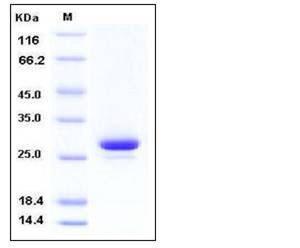Human HPGD / 15-PGDH Protein (His Tag)
15-PGDH,PGDH,PGDH1,PHOAR1,SDR36C1
- 100ug (NPP3926) Please inquiry
| Catalog Number | P11205-H08E |
|---|---|
| Organism Species | Human |
| Host | E. coli |
| Synonyms | 15-PGDH,PGDH,PGDH1,PHOAR1,SDR36C1 |
| Molecular Weight | The recombinant human HPGD comprises 272 amino acids and has a predicted molecular mass of 29.7 kDa. It migrates as an approximately 27 kDa band in SDS-PAGE under reducing conditions. |
| predicted N | Met 1 |
| SDS-PAGE |  |
| Purity | > 92 % as determined by SDS-PAGE |
| Protein Construction | A DNA sequence encoding the human HPGD (NP_000851.2) (Met 1-Gln 266) was expressed, with a polyhistidine tag at the C-terminus. |
| Bio-activity | Measured by the production of NADH during the oxidation of PGF2α. The specific activity is >1,500 pmoles/min/μg. |
| Research Area | Signaling |Signal Transduction |Other Related Intracellular Topics |Cellular Senescence and Pathways in Aging |Apoptosis |Oxidative Stress | |
| Formulation | Lyophilized from sterile 50mM Tris, 100mM NaCl, 0.5mM DTT, 10% glycerol, pH 7.5 1. Normally 5 % - 8 % trehalose, mannitol and 0.01% Tween80 are added as protectants before lyophilization. Specific concentrations are included in the hardcopy of COA. |
| Background | Mouse 15-hydroxyprostaglandin dehydrogenase [NAD+], also known as Prostaglandin dehydrogenase 1, HPGD, and PGDH1, is a member of the short-chain dehydrogenases/reductases (SDR) family. Prostaglandins (PGs) play a key role in the onset of labor in many species and regulate uterine contractility and cervical dilatation. Therefore, the regulation of prostaglandin output by PG synthesizing and metabolizing enzymes in the human myometrium may determine uterine activity patterns in human labor both at preterm and at term. Prostaglandin dehydrogenase (PGDH) metabolizes prostaglandins (PGs) to render them inactive. HPGD is down-regulated by cortisol, dexamethasone and betamethasone and down-regulated in colon cancer. It is up-regulated by TGFB1. HPGD contributes to the regulation of events that are under the control of prostaglandin levels. HPGD catalyzes the NAD-dependent dehydrogenation of lipoxin A4 to form 15-oxo-lipoxin A4. and inhibits in vivo proliferation of colon cancer cells. Defects in HPGD are the cause of primary hypertrophic osteoathropathy autosomal recessive (PHOAR) , cranioosteoarthropathy (COA), and isolated congenital nail clubbing. |
| Reference |
